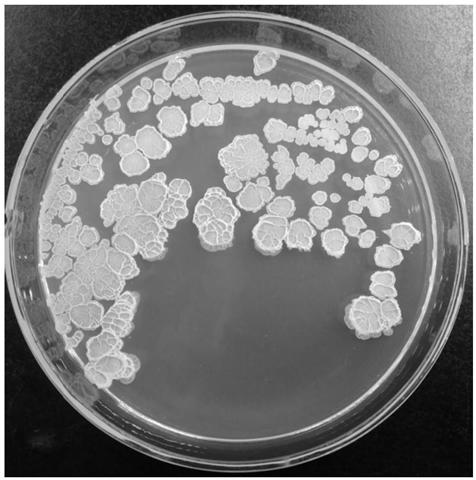Broad-spectrum antibacterial Bacillus amyloliquefaciens strain and application thereof
A technology of Bacillus amyloliquefaciens and antibacterial solution, applied in the field of microorganisms, can solve problems such as food safety and environmental pollution, and achieve the effects of stable bacteriostatic performance, strong tolerance and simple culture conditions
- Summary
- Abstract
- Description
- Claims
- Application Information
AI Technical Summary
Problems solved by technology
Method used
Image
Examples
Embodiment 1
[0037] Embodiment 1: Separation and purification of bacterial strains
[0038] Purchase aquatic products and food (freshly dissected hairtail intestines, brewed tea and fermented soybean meal) from Wushan Garden Vegetable Market, Wushan Road, Tianhe District, Guangzhou, add appropriate saline for grinding, and treat in a 70°C water bath for 30 minutes, then take 10 -1 、10 -2 、10 -3 、10 -4 、10 -5 、10 -6 、10 -7 、10 -8 The diluted solution was spread on an LB medium plate and incubated at a constant temperature of 37°C for 24h. A single colony was picked and streaked on an LB plate for isolation and repeated purification. Carry out Gram staining and microscopic examination of the purified colonies, pick out rod-shaped Gram-positive strains, and number them, then use glycerol with a final concentration of 20% as a protective agent, and store them in a -80°C ultra-low temperature refrigerator for later use .
Embodiment 2
[0039] Embodiment 2: Screening of antagonistic bacteria
[0040] (1) Preparation of Bacillus fermentation supernatant: use an inoculation loop to take a ring of liquid bacteria stored at -80°C and streak it on an LB solid plate, and culture overnight in a 37°C incubator. Pick a single colony of activated Bacillus and inoculate it in a 250mL Erlenmeyer flask filled with 50mL of LB medium, and culture it at 37°C and 200r / min for 24h to obtain an activated seed solution. The seed solution was transferred to a 250mL Erlenmeyer flask containing 100mL Landy fermentation medium according to the inoculum amount of 1%, and fermented at 30°C and 200rpm for 48h. The fermentation broth was centrifuged at 4°C and 12,000 rpm for 15 minutes to remove bacteria, and then filtered through a 0.22 μm water filter membrane to obtain a sterile fermentation supernatant, which was used for the detection of antibacterial activity.
[0041] (2) Preparation of indicator bacteria plate:
[0042] Retran...
Embodiment 3
[0045] Embodiment 3: strain identification
[0046] (1) Morphological identification: The strain JFL21 obtained by screening was isolated on LB plates by streaking, and the colony characteristics were observed after culturing at 37°C for 48 hours. The results were as follows: figure 1 As shown, the colony is milky white, round, with irregular edges, wrinkled surface, inset in the middle, opaque, and relatively dry; after being cultured in LB liquid medium for 24 hours, the single colony is purple after Gram staining, which is leather. Lambert-positive bacteria, rod-shaped, the results are shown in figure 2 .
[0047] (2) Physiological and biochemical characteristics: Classification and identification of bacterial species described in "Berger's Bacteria Identification Manual" (8th edition) and "Common Bacterial System Identification Manual" (edited by Dong Xiuzhu, Cai Miaoying, etc., Beijing: Science Press, 2001.2) The physiological and biochemical characteristics of the str...
PUM
 Login to View More
Login to View More Abstract
Description
Claims
Application Information
 Login to View More
Login to View More - R&D
- Intellectual Property
- Life Sciences
- Materials
- Tech Scout
- Unparalleled Data Quality
- Higher Quality Content
- 60% Fewer Hallucinations
Browse by: Latest US Patents, China's latest patents, Technical Efficacy Thesaurus, Application Domain, Technology Topic, Popular Technical Reports.
© 2025 PatSnap. All rights reserved.Legal|Privacy policy|Modern Slavery Act Transparency Statement|Sitemap|About US| Contact US: help@patsnap.com



